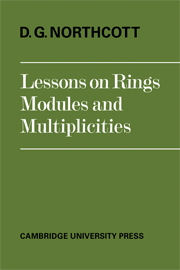Book contents
- Frontmatter
- Contents
- Preface
- Some notes for the reader
- 1 Introduction to some basic ideas
- 2 Prime ideals and primary submodules
- 3 Rings and modules of fractions
- 4 Noetherian rings and modules
- 5 The theory of grade
- 6 Hilbert rings and the Zeros Theorem
- 7 Multiplicity theory
- 8 The Koszul complex
- 9 Filtered rings and modules
- Index
6 - Hilbert rings and the Zeros Theorem
Published online by Cambridge University Press: 09 January 2010
- Frontmatter
- Contents
- Preface
- Some notes for the reader
- 1 Introduction to some basic ideas
- 2 Prime ideals and primary submodules
- 3 Rings and modules of fractions
- 4 Noetherian rings and modules
- 5 The theory of grade
- 6 Hilbert rings and the Zeros Theorem
- 7 Multiplicity theory
- 8 The Koszul complex
- 9 Filtered rings and modules
- Index
Summary
General remarks. In this chapter we continue the study of polynomial rings. Historically, the ideas presented here developed out of a single result, due to D. Hilbert, known as the Zeros Theorem. An analysis of this result drew attention to a certain special class of rings whose members are now known as Hilbert rings. The abstract theory of Hilbert rings is presented in the first section, the remaining ones being devoted to applications.
Throughout this chapter, the rings considered are assumed to be commutative and it is supposed that each possesses an identity element.
Hilbert rings
A commutative ring R is called a Hilbert ring if each prime ideal is the intersection of all the maximal ideals that contain it. A null ring is regarded as a Hilbert ring because, in this case, there is no prime ideal which fails to have the property described in the definition. Obviously any field is a Hilbert ring and, more generally, so is any ring in which every prime ideal is a maximal ideal. Also, it is easy to see that the ring formed by the integers provides another example. By contrast, a local ring is a Hilbert ring when and only when it is zero-dimensional.
Proposition 1.Let Rbea Hilbert ring and φ:R → R′ an epimorphism of R on to a ring R′. Then R′ is also a Hilbert ring.
Proof. We know that there is a natural one-one correspondence between the prime ideals of R′ and those prime R-ideals that contain the kernel of φ.
Information
- Type
- Chapter
- Information
- Lessons on Rings, Modules and Multiplicities , pp. 274 - 288Publisher: Cambridge University PressPrint publication year: 1968
